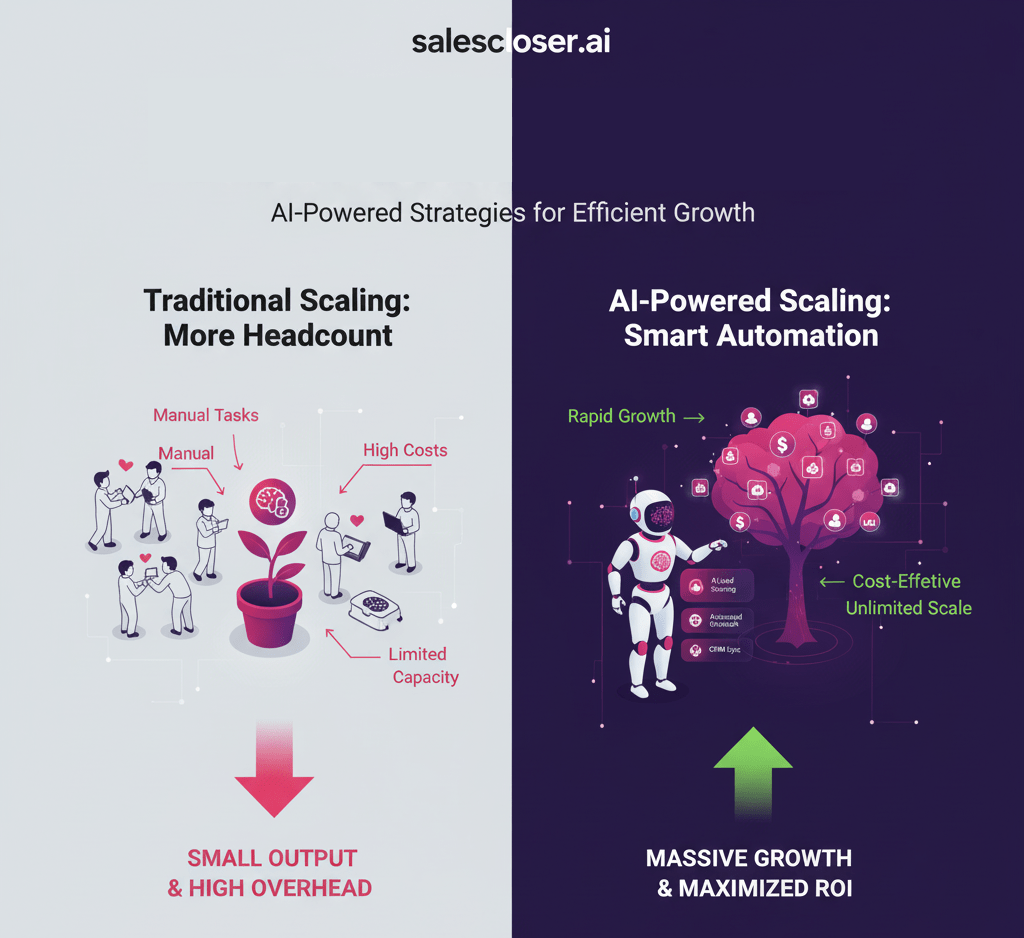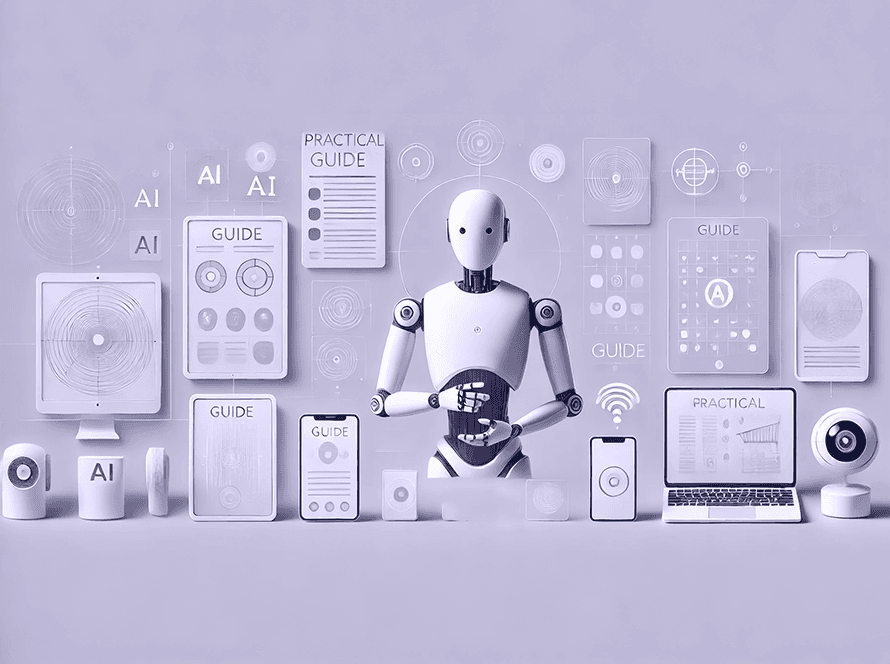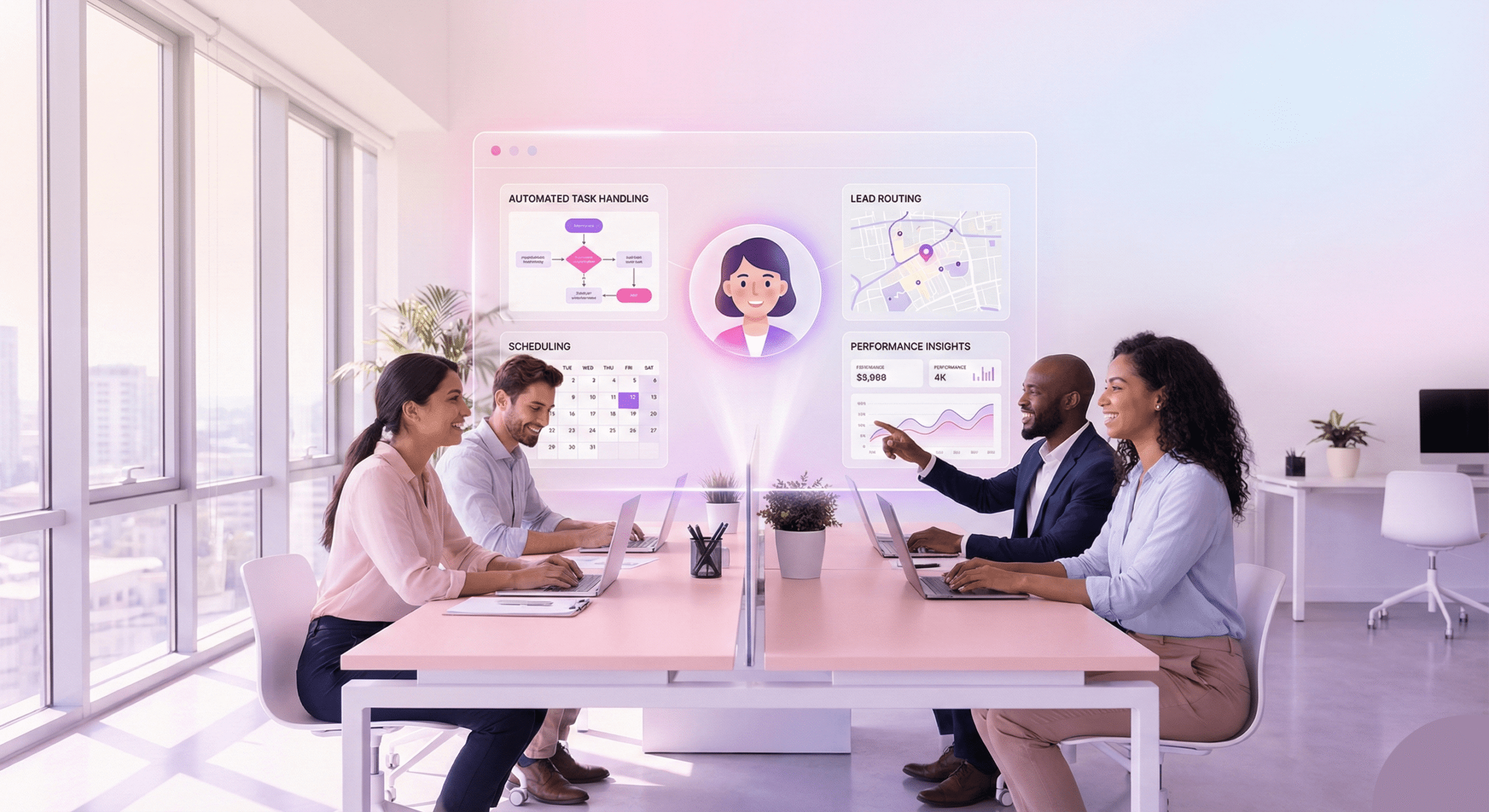“Unlock massive, cost-effective pipeline growth by using AI to autonomously automate cold calls and qualification—the true How to Scale Lead Generation without Increasing Headcount.”
You’re staring at the growth chart. The line is trending up, but not fast enough. Your board, your investors, and your own ambition demand more. The knee-jerk reaction? “We need more leads. Let’s hire more SDRs.” It’s the traditional sales growth formula, etched into the stone tablets of business school lore. But what if that formula is broken? What if hiring more people is actually the slowest, most expensive, and least efficient way to scale?
The pressure to grow revenue is immense. Yet, the cost of that growth can be extreme. Every new hire adds salary, benefits, training costs, software licenses, and management overhead to your balance sheet. The process is slow, the results are unpredictable, and the churn rate for entry-level sales roles is notoriously high. You’re caught in a frustrating cycle: you need more pipeline to justify the cost of new hires, but you need new hires to build that pipeline. It’s a classic chicken-and-egg problem that stunts growth for countless promising companies.
This is not another article about “sales hacks” or minor productivity tips. This is a strategic playbook for fundamentally changing your approach to growth. It’s about building a scalable sales model that generates a massive, predictable pipeline without the corresponding surge in headcount and operational costs. We will explore how to identify and automate the most repetitive, time-consuming parts of your sales process. Then, we will show you how to execute this playbook with a powerful new class of technology that acts as a force multiplier for your existing team. Get ready to learn how to scale lead generation without increasing headcount and finally break free from the traditional, costly model of sales expansion.
The Hidden Costs of the “More SDRs” Fallacy
For decades, the solution to pipeline generation has been linear: more leads require more human activity, which means more humans. The Sales Development Representative (SDR) or Business Development Representative (BDR) became the engine room of the B2B sales machine. Their job is a grind—a high-volume, repetitive cycle of prospecting, cold calling, and initial qualification. While essential, this model is built on a foundation of inefficiency and staggering costs that are often overlooked.
Deconstructing the True Cost of an SDR
When you decide to hire a new SDR, the on-paper salary is just the tip of the iceberg. The true, fully-loaded cost paints a much more sobering picture. Let’s break it down.
- Base Salary and Benefits: According to Glassdoor and other industry reports, the average base salary for an SDR in the United States hovers around $55,000, with on-target earnings (OTE) reaching $75,000 or more. Add to that payroll taxes, health insurance, retirement contributions, and other benefits, and you’re easily looking at a 20-30% increase on top of the base salary. Suddenly, that $55k hire is a $70k+ annual expense.
- Recruiting and Onboarding: Finding and hiring the right person can be a costly process. You may need to pay for recruiters, job board postings, and spend significant internal person-hours on interviewing and vetting candidates. Once hired, the clock starts ticking on training. A new SDR doesn’t become productive overnight. The ramp-up period, typically lasting three to six months, is a period where you are paying a full salary for minimal output. During this time, you are investing manager and trainer time, resources, and energy into getting them up to speed.
- Tools and Technology: Your new SDR needs a toolkit to even begin doing their job. This includes a seat for your CRM (like Salesforce or HubSpot), a sales engagement platform (like Outreach or Salesloft), a data provider (like ZoomInfo or Seamless.ai), and a LinkedIn Sales Navigator license. These subscriptions add up quickly, often costing several thousand dollars per representative per year.
- Management Overhead: An SDR doesn’t operate in a vacuum. They require a manager for coaching, performance reviews, and daily guidance and support. A good rule of thumb is one manager for every 6 to 8 SDRs. As you scale the team, you inevitably have to scale the management layer, adding another significant salary to the department’s overhead.
When you add it all up, the actual cost of a single SDR can easily exceed $100,000 in its first year. If your goal is to increase your lead volume significantly, you may need a team of five to ten SDRs. You are now looking at a seven-figure annual investment before a single deal is closed from their efforts. This is a massive gamble on a role that, by its very nature, is a significant source of inefficiency.
The Inherent Inefficiencies of Manual Prospecting
Beyond the direct financial costs, the manual SDR model is plagued by operational inefficiencies. The core tasks of an SDR are not a high-value use of a human’s time.
Think about a typical day. An SDR spends hours building lists, researching contacts, and manually dialing numbers. A considerable percentage of these calls are directed to voicemail or intercepted by gatekeepers. Of the calls that do connect, many are with people who are not the right fit, not interested, or not the decision-maker. It is a process defined by rejection and low conversion rates. An industry benchmark suggests that it can take over 80 dials for a typical SDR to book just one meeting.
This relentless, low-yield activity leads to one of the most significant problems in the sales world: SDR burnout and turnover. The average tenure of an SDR is often less than 18 months. This high churn rate means you are constantly in a state of recruiting, hiring, and training, perpetually restarting the expensive and time-consuming ramp-up process. You’re running a sales talent conveyor belt, and the cost of replacing each person who leaves is estimated to be at least 50% of their annual salary. This is not a foundation for sustainable business growth. It’s a leaky bucket that drains resources, morale, and momentum.
The fundamental issue is that you are using expensive, creative, and ambitious human beings to perform tasks that a machine could do more efficiently. You are paying for human intelligence and then asking them to act like robots. This is the core fallacy we must address to build a truly cost-effective lead generation engine.
The Playbook: How to Architect a Scalable Sales Model
To escape the linear growth trap, you need a new playbook. The goal is to decouple revenue growth from headcount growth. This isn’t about making your team work harder; it’s about fundamentally redesigning the machine. The core principle is simple: Automate the low-value, repetitive tasks to liberate your human talent to focus exclusively on high-value, revenue-generating activities.
Your best salespeople are closers, strategists, and relationship builders. Their time is most valuable when they are in conversations with qualified, interested buyers. Every minute they spend on cold prospecting or scheduling logistics is a minute they aren’t closing deals. Our playbook is designed to eliminate non-essential tasks from their workload systematically.
It consists of three primary steps:
- Audit and Isolate: Meticulously map your current sales process to identify the automatable, top-of-funnel bottlenecks.
- Automate and Execute: Implement technology that not only assists humans but also autonomously executes these repetitive tasks at scale.
- Reallocate and Elevate: Refocus your human sales talent on the activities that require empathy, strategic thinking, and a human touch—namely, closing deals.
Let’s dive into the specifics of each step.
Step 1: Audit Your Funnel for Automation Hotspots
You can’t fix what you don’t measure. The first step is to perform a brutally honest audit of how your sales team spends its time. Your goal is to pinpoint the exact activities that consume the most hours for the least proportional return at the top of the funnel.
Get granular. Sit down with your sales representatives and SDRs to map out their day-to-day activities, or use a time-tracking tool for a week to track their activities. Create a detailed process map that covers the entire journey, from identifying a lead to scheduling the first meeting. For each step, ask:
- How much time does each activity require?
- How many times is this activity performed daily or weekly?
- Does this task require strategic thinking, emotional intelligence, or complex problem-solving?
The bulk of their time is likely sunk into a few key areas. These are your automation hotspots:
- Prospect List Building: Manually searching LinkedIn, company websites, and databases to find names, titles, and contact information.
- Initial Outreach (The Cold Call Grind): The act of dialing hundreds of numbers, navigating phone trees, speaking with gatekeepers, and leaving voicemails.
- Repetitive Email Follow-Up: Sending the same “just checking in” emails over and over again to unresponsive prospects.
- Basic Lead Qualification: Asking the same set of initial screening questions to every prospect who shows a glimmer of interest. This includes questions like, “What’s your company size?” “What’s your role?” “Are you the decision-maker?”
- Appointment Setting Logistics: The endless email back-and-forth trying to find a mutually available time on the calendar for a discovery call.
Once you have identified these tasks, quantify the waste. For example, suppose you have five SDRs and they each spend 15 hours a week on manual dialing and initial qualification (a very conservative estimate). In that case, that’s 75 hours of paid time every single week dedicated to low-conversion activities. That’s nearly two full-time employee equivalents spent on tasks that are ripe for automation. This calculation makes the problem tangible and builds a robust business case for investing in a solution. It’s the first crucial step to maximize marketing ROI and create a leaner operation.
Step 2: Implement True Automation, Not Just Assistance
Now that you know what to automate, the next step is how. This is where most companies take a wrong turn. They invest in “lead generation automation tools” that are merely assistance software. Email sequencers, power dialers, and data enrichment tools are helpful, but they don’t solve the core problem. They help humans perform repetitive tasks faster, but they still require human operation. A power dialer helps an SDR make 150 calls a day instead of 80, but it’s still the SDR making the calls, facing the rejection, and spending their time on a low-yield activity.
This is simply optimizing an inefficient process. True transformation requires a leap to the next level: AI-powered lead gen.
The difference is profound. Assistance tools are like giving a construction worker a better hammer. An AI agent is like giving them a team of autonomous robots that can build the foundation for them. Instead of helping your SDRs make more calls, an AI sales agent makes the calls for them. It autonomously executes the entire top-of-funnel sequence, encompassing prospecting, engagement, qualification, and scheduling.
This is the technology layer of our playbook. It’s about deploying a system that can handle these tasks at a scale and efficiency that is beyond human capability. It runs 24/7, never gets tired, never has a bad day, and can execute thousands of outreach activities with perfect consistency. This is how you achieve exponential, not incremental, gains in your lead generation efforts and truly do more with less in sales.
Step 3: Reallocate Your Humans to High-Value Closing Activities
With a powerful automation engine handling the top of your funnel, what happens to your SDRs? This is the most exciting part of the playbook, and it directly addresses the fear of “replacing” people. You don’t fire them; you repurpose and elevate them.
Your former SDRs, who are now freed from the soul-crushing grind of cold outreach, can be retrained and repositioned into more valuable roles.
- Closing Roles: The most promising SDRs can be fast-tracked into Account Executive (AE) positions. They can now spend 100% of their time on a calendar full of pre-qualified, high-intent meetings that were booked for them. Their job becomes about building relationships, demonstrating value, and closing deals. This creates a powerful, internal career path, which dramatically improves employee retention.
- Hybrid Roles: They can become “Meeting Setters” or “Qualification Specialists,” handling the immediate follow-up from the AI-generated meetings to provide a human touchpoint before the AE takes over. This ensures a smooth handoff and a premium experience for the prospect.
- Customer Success or Account Management: Their deep understanding of customer pain points, gained from their time on the front lines, makes them excellent candidates for roles focused on retaining and expanding existing accounts.
The result is a more specialized, more effective, and more satisfied sales organization. Your highly-paid AEs are no longer wasting their time on prospecting and can focus entirely on closing. Your junior talent gets to skip the most grueling part of the sales career ladder and move directly into more strategic, fulfilling roles. This is how you reduce reliance on SDRs in the traditional sense and build a team of true sales professionals, all while creating a hyper-efficient pipeline machine.

The Ultimate Execution Engine: SalesCloser.ai
You have the playbook. You understand the strategy of auditing, automating, and reallocating. Now, you need the tool to execute it. This is where SalesCloser.ai comes into play. It’s not just another piece of software; it’s the purpose-built platform designed to run this entire playbook for you. SalesCloser.ai provides a scalable, virtual sales team in the form of a knowledgeable AI sales agent.
SalesCloser.ai is not a dialer or an email bot. It is a conversational AI that can autonomously handle the entire top-of-funnel sales process over the phone. It thinks, listens, and responds like a human, allowing you to scale your outreach efforts to a level that would otherwise require hiring an entire army of SDRs.
Your 24/7 Autonomous Prospecting Team
Imagine an SDR who can make thousands of calls a day. They never need a break, never get discouraged, and ideally follow the script every single time. That is SalesCloser.ai. You provide the contact list, and the AI agent goes to work, tirelessly dialing prospects. It can navigate complex phone trees, gracefully interact with gatekeepers, and engage decision-makers in natural, unscripted conversations.
The technology behind this is sophisticated. It leverages advanced natural language processing (NLP) and machine learning to understand context, tone, and intent. This isn’t the robotic “Press 1 for sales” experience. This is a fluid conversation. The AI can answer questions, handle common objections (“I’m not interested,” “Send me an email,” “We already have a vendor”), and intelligently guide the conversation toward the qualification criteria you’ve set.
Intelligent, Criteria-Based Lead Qualification
This is where the platform truly shines. Before launching a call campaign, you define precisely what a qualified lead looks like for your business. You build your custom qualification criteria directly into the AI’s brain. This could be based on the BANT framework (Budget, Authority, Need, Timeline) or any other set of questions specific to your product or service.
- Need: Does the prospect have the specific pain point your solution solves?
- Company Size: Are they within your ideal customer profile (ICP) in terms of employee count or revenue?
- Authority: Is this person the decision-maker or a key influencer in the buying process?
- Timeline: Are they looking to make a purchase decision within a specific timeframe (e.g., this quarter)?
During the conversation, the AI agent isn’t just reading a script; it’s on a mission to gather this information. It dynamically asks the right questions to determine if a prospect meets your predefined thresholds. Only when a lead is confirmed to be qualified against your exact criteria does the AI take the next step. This ensures that your sales team’s calendar is filled exclusively with high-probability opportunities, dramatically increasing their efficiency and close rates.
Seamless, Automated Appointment Setting
Once a lead is qualified, the most frustrating part of the sales process begins: scheduling the meeting. For human reps, this often involves a series of emails and phone calls, wasting valuable time and creating an opportunity for the prospect to go cold.
SalesCloser.ai eliminates this friction. The moment the AI agent qualifies a lead on the call, it taps directly into your sales team’s live calendars via API integration. It can display real-time availability and offer prospect-specific open slots. For example, the AI might say, “Great, it sounds like it would be beneficial to connect you with one of our specialists. I see they have some time available tomorrow at 10:00 AM or 2:00 PM. Does either of those work for you?”
The prospect agrees to a time, and the AI instantly books the meeting, sends out the calendar invites to both parties, and logs the activity in your CRM. The human sales rep doesn’t have to do anything. They simply look at their calendar and see a new, fully qualified meeting waiting for them. This is the definition of a scalable sales model. It’s a closed-loop system that runs independently, providing your closers with a steady stream of opportunities, enabling you to grow revenue efficiently without the logistical headaches.
The Overwhelming ROI: A Tale of Two Growth Strategies
Let’s make this tangible with a clear financial comparison. Imagine your company’s goal is to book an additional 150 qualified meetings per month.
Strategy A: The Traditional Headcount Model
To achieve this goal by hiring, you’d need to build a significant SDR team. Let’s be conservative:
- Assume a good SDR can book 30 qualified meetings per month.
- To get 150 meetings, you would need to hire five SDRs.
- Using our earlier calculation, the fully loaded first-year cost for one SDR is approximately $100,000.
- Your total annual investment to build this team would be $500,000.
- This doesn’t even account for the 3-6 month ramp-up time, during which you’re paying full salaries for partial output, or the inevitable costs of turnover.
Strategy B: The Automated SalesCloser.ai Model
Now, let’s run the same scenario using SalesCloser.ai as your virtual sales team.
- One AI Sales Agent can perform the work of 5, 10, or even more SDRs, making thousands of calls and engaging prospects around the clock.
- The platform can easily be configured to target the volume required to generate 150 qualified meetings per month.
- The cost of SalesCloser.ai is a predictable, recurring software subscription, which is a tiny fraction of the cost of even a single SDR’s salary.
- Your total annual investment might be closer to $30,000 – $50,000, depending on the scale of your campaigns.
The difference is staggering. With the AI-powered model, you achieve the same or better results for approximately 90% less cost. Furthermore, the time-to-value is almost immediate. There is no three-month ramp-up period. The system can be live and generating leads within days. This isn’t just an improvement; it’s a complete paradigm shift in the economics of customer acquisition and a clear path to sustainable business growth.
It’s Time to Build a Smarter Growth Engine
The traditional approach to scaling sales is outdated. Tying your company’s growth directly to the number of people you can hire is a slow, expensive, and unpredictable path to success. It creates a fragile system that is vulnerable to high turnover and market fluctuations. The future of sales belongs to businesses that can build efficient, technology-driven systems that generate a predictable pipeline on demand.
The playbook is straightforward: audit your process to identify waste, implement true AI automation to execute repetitive tasks at scale, and empower your talented people to focus on what they do best—closing. By doing so, you’re not just improving your sales process; you’re building a durable competitive advantage.
SalesCloser.ai is the engine that drives this modern playbook. It’s your opportunity to build a virtual, scalable sales team that works tirelessly to grow your business, enabling you to achieve exponential growth without incurring the associated costs.
Ready to stop hiring and start scaling? Discover how SalesCloser.ai can transform your lead generation. Book a Demo Today.
Frequently Asked Questions (FAQs)
Q1: Will an AI agent sound robotic and turn off our prospects?
This is a common and understandable concern, rooted in outdated technology. However, modern conversational AI, like the one powering SalesCloser.ai, is incredibly advanced. It employs human-like intonation and pacing and can comprehend conversational nuances. It doesn’t sound like a typical “robocall” because it’s not a pre-recorded message; it’s a dynamic AI generating responses in real-time. The goal is to have a conversation that is so natural that the prospect may not even realize they’re speaking with a human.
Q2: Our sales process is complex. Can an AI really handle it?
Absolutely. The platform is designed for customization. You aren’t using a generic script. You work with the SalesCloser.ai team to embed your specific value propositions, product details, and qualification criteria into the AI. It can be trained on your industry’s jargon, your key differentiators, and your proven objection-handling techniques. It’s built to execute your proven process, just at a massive scale.
Q3: Will this replace our existing SDRs?
No, it empowers them. The goal is to reduce reliance on SDRs for the most painful part of their job. By automating the top-of-funnel grind, you free your human talent to focus on more strategic activities. Your SDRs can be promoted to closers, or they can focus on nurturing the high-intent leads generated by the AI, providing a human touchpoint to build rapport before the demo. It transforms the SDR role from a burnout factory into a valuable talent pipeline for your entire sales organization.
Q4: How does SalesCloser.ai integrate with our current tech stack, like our CRM?
Seamless integration is a core feature. SalesCloser.ai is designed to integrate directly with popular CRMs, including Salesforce, HubSpot, and others. Every call, every interaction, and every booked meeting is automatically logged in your system of record. This ensures data hygiene, provides complete visibility for sales leadership, and creates a frictionless workflow between the AI’s activities and your team’s follow-up actions.
Q5: What kind of businesses see the most success with this model?
Any B2B company that relies on outbound calling to generate leads can benefit, but it’s especially powerful for organizations with a high sales volume or an ambitious growth target. This includes SaaS companies, marketing agencies, financial services firms, and any business that needs a predictable and scalable way to fill the top of their sales funnel without increasing their operational costs.
Q6: How do we measure the ROI and ensure it’s working?
The ROI is crystal clear and easy to measure. The platform provides detailed analytics dashboards that show key metrics, including calls made, conversations had, leads qualified, and meetings booked. You can directly track the cost per meeting and cost per opportunity generated by the AI. You simply compare this to your previous customer acquisition cost from the SDR team. The financial savings on salary and overhead, combined with the massive increase in qualified meetings, make the ROI undeniable.








